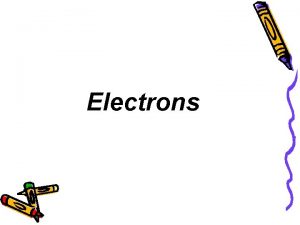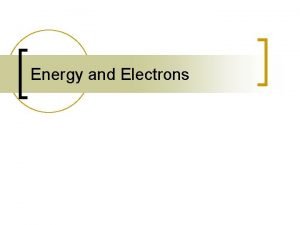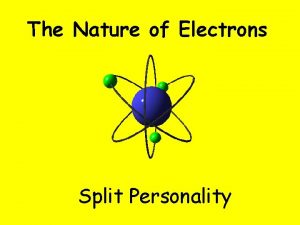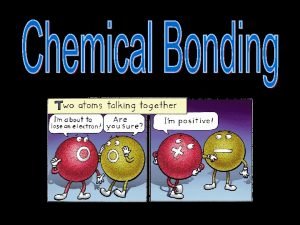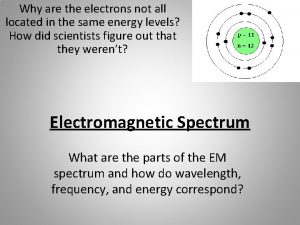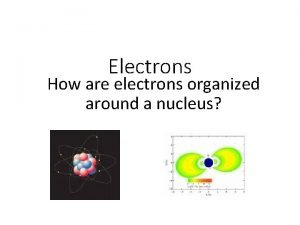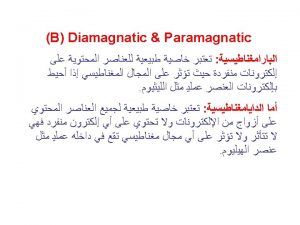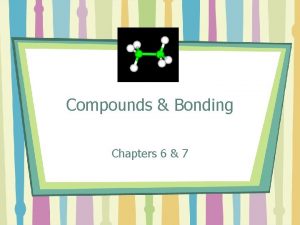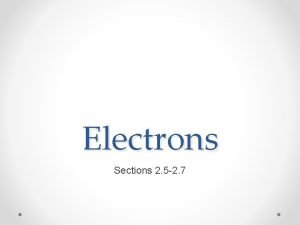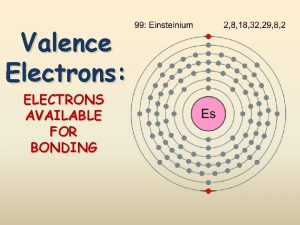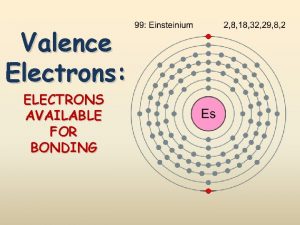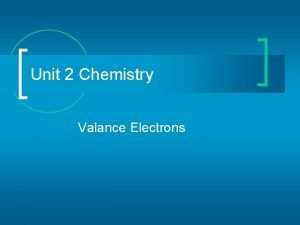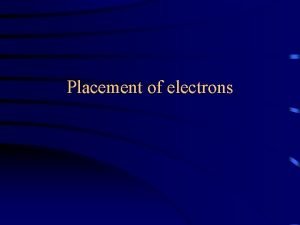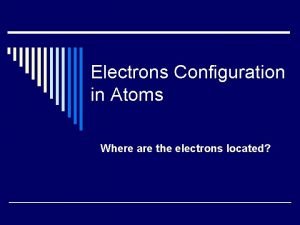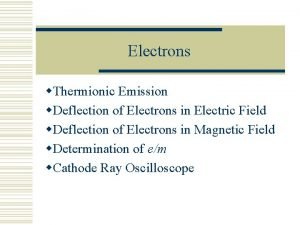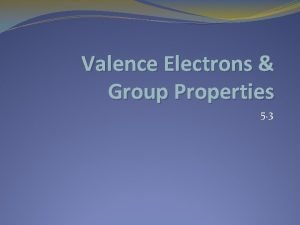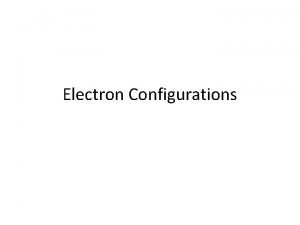Electrons Electrons Where are the electrons located in




































- Slides: 36

Electrons

Electrons: • Where are the electrons located in an atom? • Does the arrangement/placement matter?

Valence Electrons: • Electrons in the outer most shell (or outer most level) of an atom • ****Important**** because determine how reactive an element is

What # makes them stable? • Atoms want 8 valence electrons to be “stable”. • There are 2 exceptions to this… what are they?

• Why don’t electrons completely fill the 3 rd principal energy level before they start to fill the forth?


Symbol p+ n 0 Mg Atomic Charge Number Mass 25 8 Os e- +2 8 -2 114 +3 Part I: Columns… aka Groups… 88 aka Families 0

DECIPHERING THE PERIODIC TABLE Part I: Columns… aka Groups… aka Families

John Newlands • 1865 – arranged the known elements according to their properties and in order of increasing atomic mass – Noticed all of the elements in a given row had similar chemical and physical properties. • Law of Octaves- properties repeated every 8 elements

H 1 F 8 Cl 15 Co/Ni 22 Br 29 Pd 36 I 42 Pt/Ir 50 Li 2 Na 9 K 16 Cu 23 Rb 30 Ag 37 Cs 44 Tl 53 Gl 3 Mg 10 Ca 17 Zn 25 Sr 31 Cd 34 Ba/V 45 Pb 54 Bo 4 Al 11 Cr 18 Y 24 Ce/La 33 U 40 Ta 46 Th 56 C 5 Si 12 Ti 19 In 26 Zr 32 Sn 39 W 47 Hg 52 N 6 P 13 Mn 20 As 27 Di/Mo 34 Sb 41 Nb 48 Bi 55 O 7 S 14 Fe 21 Se 28 Ro/Ru 35 Te 43 Au 49 Os 51

Dmitri Mendeleev (1869) • Used Newlands observations • Listed elements in columns according to atomic mass…. then arranged columns so elements of similar properties were side by side

Two Interesting Observations: 1) Mendeleev left gaps in the table and predicted particular properties those elements should have • Those elements were discovered and his predictions were true 2) Switched the order of Tellurium (Te) and Iodine (I)


Henry Moseley (1887 -1915) • 1913 - made his own periodic table • Arranged elements by atomic number British Physicist… bookworm…

Elements: left right by atomic #

Periodic Table • Horizontal Rows: called periods – Periodic Law: when the elements are arranged in order of increasing atomic number, there is a periodic repetition of their physical and chemical properties Vertical Columns: Groups or Families

Metals: • ~80% of all elements are metals • High electrical conductivity and have a high luster when cleaned • Ductile (can be made into wires) and Malleable • Are solid at room temperature except for one… which one is it? • Hint: Think “Barometer”

• Group 1: Alkali Metals – Except Hydrogen, all react vigorously with water • Group 2: call Alkaline Earth Metals

Non-Metals: • Generally nonlustrous… which means not shiny • Generally poor conductors of electricity

Specific Group Names: • Group 17 - Halogens • Like halogen lamps • Group 18 - Noble Gases • Sometimes called inert gases • Undergo few chemical rxns

Metalloids • Intermediate Properties • Semi-Conductors

Moving into Bonding…

Bonding: • How do atoms bond together to form molecules? – Electrons… specifically the valence electrons • What are valence electrons again?

First Things First: • First we need to learn how to draw the appropriate symbols. • Lewis Dot Structure- consists of the chemical symbol for the element plus a dot for each valence electron

EXAMPLE TIME • • • Na Mg C P F

Types of Bonding: • 2 main types of bonding: – Ionic and Covalent • Ionic Bond: electrostatic forces that exist between ions of opposite charges

Ionic Bond • “Bond. Ionic Bond. Taken, not shared. ” • Happens between metals and nonmetals. • One atom “takes” the electron from another – forming ions

Ions • Cations- positively charged ions • Anions – negatively charged ions

Let’s Back Track A Little: • Ions and Ionic Compounds – In general, metal atoms tend to lose electrons to form cations (positive ions), whereas nonmetal atoms tend to gain electrons to form anions (negative ions)

Predicting Ions: • Look at the periodic table… what charge do you think Group I ions are likely to have? Group 2? Group 13? Group 15? Group 16? Group 17? – Group 1 – likely to lose 1 electron… so (+1) – Group 2 – (+2) – Group 13 – (+3) – Group 15 – (-3) – Group 16 – (-2) – Group 17 – (-1)

Chemical Formula: • Textbook Definition: A notation that uses chemical symbols with numerical subscripts to convey the relative proportions of atoms of the different elements in a substance • Tells you what something is made of using the element’s symbols

Nomenclature (aka, Naming): • Chemists like to name things… we’ve talked about those annoying chemists… so how do we know that Na. Cl is called sodium chloride instead of N-a - C-l ? • Let’s name Cation, Anions, and then Ionic Compounds…

Cations (positive ions): • Cations formed from metal atoms have the same name as the metal ion – Na+ (sodium ion) – Zn+2 (zinc ion) – Al+3 (aluminum ion)

Cations (positive ions) Cont’d: If a metal can form cations of different charges, the positive charge is given by a Roman numeral in parentheses following the name of the metal – Example: Iron • Fe+2 iron (II) ion • Fe+3 iron (III) ion Cu+ copper (I) ion Cu+2 copper (II) ion

Anions (negative ions): • Monatomic anions have names formed by replacing the ending of the name of the element with “-ide” – H- Hydride – O-2 Oxide N-3 Nitride

Ionic Compounds: • Consist of cation name followed by the anion name… – Basically name the first part, then the second part – Ca. Cl 2 – Al(NO 3)3 calcium chloride aluminum nitrate
 Antigentest åre
Antigentest åre Thế nào là mạng điện lắp đặt kiểu nổi
Thế nào là mạng điện lắp đặt kiểu nổi Cách giải mật thư tọa độ
Cách giải mật thư tọa độ Lời thề hippocrates
Lời thề hippocrates Vẽ hình chiếu đứng bằng cạnh của vật thể
Vẽ hình chiếu đứng bằng cạnh của vật thể Glasgow thang điểm
Glasgow thang điểm Quá trình desamine hóa có thể tạo ra
Quá trình desamine hóa có thể tạo ra Khi nào hổ mẹ dạy hổ con săn mồi
Khi nào hổ mẹ dạy hổ con săn mồi Dạng đột biến một nhiễm là
Dạng đột biến một nhiễm là điện thế nghỉ
điện thế nghỉ Các châu lục và đại dương trên thế giới
Các châu lục và đại dương trên thế giới Bổ thể
Bổ thể Nguyên nhân của sự mỏi cơ sinh 8
Nguyên nhân của sự mỏi cơ sinh 8 độ dài liên kết
độ dài liên kết 101012 bằng
101012 bằng Thiếu nhi thế giới liên hoan
Thiếu nhi thế giới liên hoan Phối cảnh
Phối cảnh Chúa sống lại
Chúa sống lại Một số thể thơ truyền thống
Một số thể thơ truyền thống Hệ hô hấp
Hệ hô hấp Công thức tính độ biến thiên đông lượng
Công thức tính độ biến thiên đông lượng Bảng số nguyên tố lớn hơn 1000
Bảng số nguyên tố lớn hơn 1000 Tỉ lệ cơ thể trẻ em
Tỉ lệ cơ thể trẻ em đặc điểm cơ thể của người tối cổ
đặc điểm cơ thể của người tối cổ Các châu lục và đại dương trên thế giới
Các châu lục và đại dương trên thế giới ưu thế lai là gì
ưu thế lai là gì Thẻ vin
Thẻ vin Môn thể thao bắt đầu bằng từ chạy
Môn thể thao bắt đầu bằng từ chạy Tư thế ngồi viết
Tư thế ngồi viết Bàn tay mà dây bẩn
Bàn tay mà dây bẩn Hình ảnh bộ gõ cơ thể búng tay
Hình ảnh bộ gõ cơ thể búng tay Từ ngữ thể hiện lòng nhân hậu
Từ ngữ thể hiện lòng nhân hậu Trời xanh đây là của chúng ta thể thơ
Trời xanh đây là của chúng ta thể thơ Tư thế ngồi viết
Tư thế ngồi viết Thế nào là giọng cùng tên
Thế nào là giọng cùng tên Chó sói
Chó sói Thơ thất ngôn tứ tuyệt đường luật
Thơ thất ngôn tứ tuyệt đường luật





































